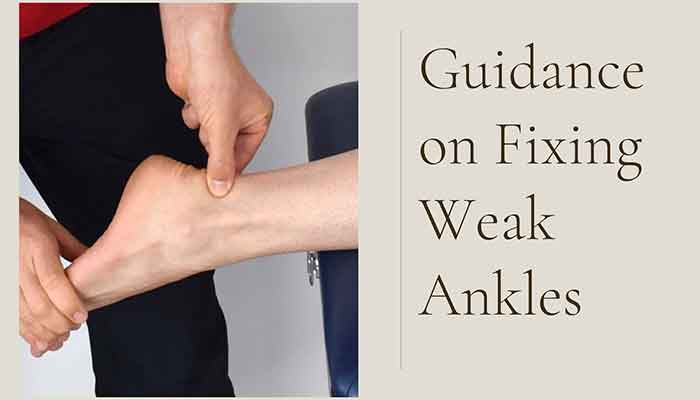If you are an active person with a lot to do or an outdoor fanatic, an ankle injury can feel more like an unfair arrest or being benched during a memorable final match. What’s worse, you can’t stop worrying if you’ll ever be okay.
But don’t worry, you will be okay.
Ankle injuries are common among active individuals i.e. runners, players, and outdoor workers. Some can accidentally trip and dislocate their ankle joints. So before you can ask yourself-what can you do for weak ankles- you first need to know the cause.
Legs get a bit deeper into the possible ankle problems so you can understand exactly what you are dealing with.
- Chronic ankle instability
There is a strong possibility you don’t even know you belong to this group. So what are the signs? First, if you had a past serious ankle dislocation, then this repeat session indicates that you have a serious problem in your hands.
Secondly, how many times has your ankle been problematic? More than two? If so then you have a case of chronic ankle instability. There is also something called ligament laxity. This is a condition where the ligaments in the ankle fail to offer maximum support. It’s usually a sign that your ankle problem is serious.
- Weak ankles
A weak ankle is a temporary problem that can be handled once and it stops being a problem. Normally, this happens after a sprain or any other injury that affects the connective tissues in the ankle region. Unfortunately, if an injury causes a serious issue, then that becomes a chronic condition.
- PTTD (Tendon Dysfunction)
Some people were naturally born with ankle problems-especially those with flat feet. So their feet tend to naturally collapse inwards. Normally, this is never a problem until someone engages in hyperactivity that inflames the tendon. That’s when they realize they need ankle support shoes.
- Osteoarthritis (OA) ankle problems
There’s one thing we all know about any arthritis-it breaks down the cartilages holding joints together. Now when this happens to ankle joints, you definitely should be addressing osteoarthritis. Joint, cartilage, or ligament injuries are the precursors of OA.
- Wearing bad shoes
There is enough evidence pointing at bad shoes as one of the causes of ankle pain, claw toes, and hallux limitus. Just to be clear, improper shoes are those that are too long, short, wide, narrow, and possibly with improper support.
- Diabetes
You probably don’t do lots of walking, running, or outdoor adventures. Unfortunately, your ankles feel weak. If you have diabetes, then that’s the culprit. This condition is associated with nerve damage which spreads out to other parts of the body including the ankles and the foot. If this is you, then you should know much about reliable diabetes shoes. If not, then get acquainted fast in order to enjoy your daily walks.
- Overweight

Unfortunately, packing a lot of weight exposes you to all kinds of ailments. We know you already know this and that you most definitely are doing something about it. You see, all your weight is supported by the feet and the ankles too take the toll. So always workout. As long as you are consistent, you’ll soon see some positive change.
The good news is, no matter how you got your ankle problems, there are multiple effective solutions to restoring sanity to your feet. Let delve into a few of them:
Here’s what you can do for weak ankles
The following are a few approaches that come highly recommended:
- Exercise

Weak muscles in the ankles are a sign that you are living a pretty much sedentary life. Regular exercising not only speeds up the metabolism but toughens every ligament and muscle in your body.
But there’s a catch.
Not every exercise will be ideal for your ankle problem-especially if you have swollen ankles. You must find the sweet spot. Sometimes a few stretches could speed up your recovery time.
Some of the low-risk activities that you can engage in include flexing, stretching, standing calf raises, drawing alphabet letters on the ground with your feet, resistance push (with a resistance band), and hand-foot war.
- Buy the right shoes
We can all agree that the best ankle support shoes should come in either mid-cut or high-top designs. This way, your ankles get locked in place from twisting in or out. Some technologies like ASIC’s Rollbar guide the foot in proper motion and this prevents missteps that are dangerous to the ankle joint.
It’s also important to prioritize arch support shoes if you have either flat feet or high-sitting arches.
- Use custom orthotics
There are stellar arch support shoes and then there are those that need customization. Most people with normal feet don’t need arch support and can take any shoe for a spin. Unfortunately, those with flat feet or higher arches must invest in custom orthotics to get the right walking experience.
If you are a fan of orthotics, then understand that you must prioritize shoes that accommodate orthotics as others don’t.
- Brace up
Extreme wear and tear of the ankles is common in super active individuals. We are talking about athletes, hikers, soccer players, and other outdoorsy people. You can also accidentally dislocate your ankle to some serious levels to warrant wearing braces.
- Lose weight
Being overweight means your ankles have a lot to support. And this translates to excess stress. Therefore, you must commit to making lifestyle changes that will help you shed extra weight and lighten the load for your feet.
- Visit a podiatrist

There are various instances where the help of a podiatrist is mandatory. These could include extremely weak ankles and balance problems (possibly signifying neurological disorders). If you are overweight, it would also be better to receive recovery directions from a certified podiatrist.
Wrap up
Weak ankles should not stop you from being productive in life. There’s plenty of solutions-some are not that expensive. Shoes, for instance, can help you stabilize your ankle and be able to accomplish your everyday’s goals. Understand that not any other everyday shoes will do. Only those with proper support will cut it.
But first, before you rush into adopting any healing approach, it’s better to understand the cause of your ankle problems.
It’s not okay to go for braces when all you needed was shoes. Similarly, it’s pointless to self-diagnose when your problem needs the attention of a podiatrist or physical therapist. So make sure you know the cause before attempting to fix your ankle problems yourself. All in all, we wish you a quick recovery.

